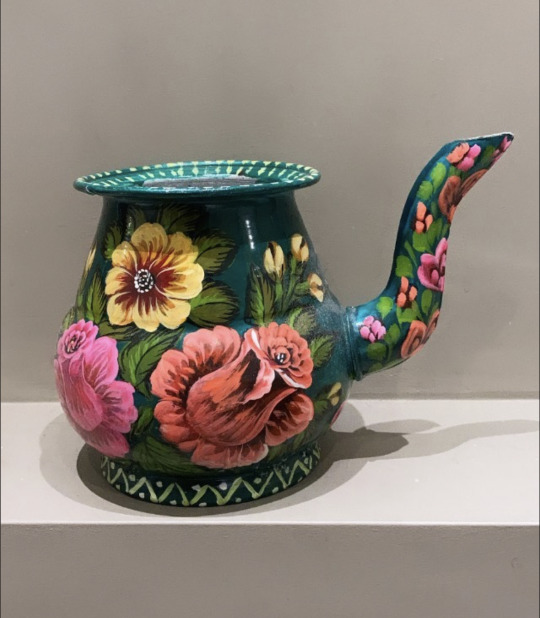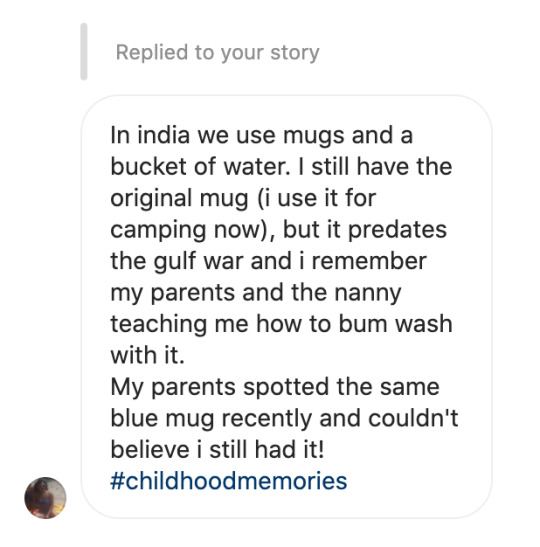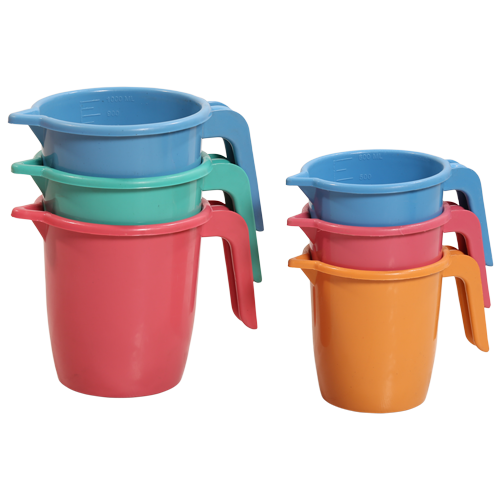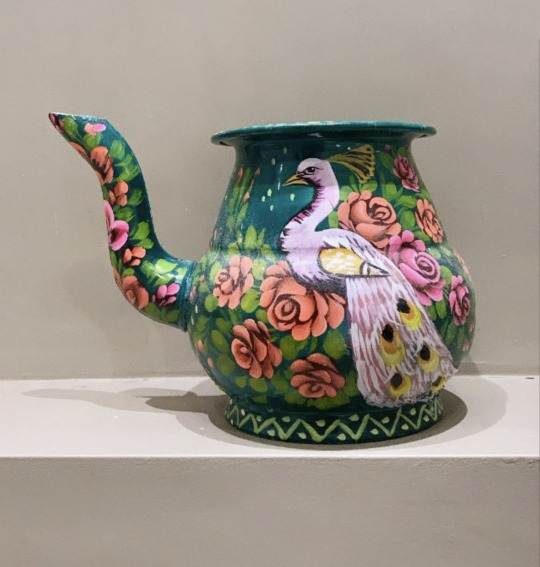#squakyclean
Explore tagged Tumblr posts
Text
Lota Power
Some years ago a British friend stopped by for a visit. After we finished our dinner, he proceeded to excuse himself to use the washroom. Some time lapsed, and he emerged scratching his head, utterly confused, as if he had seen a hippopotamus in there.
“Mariam!”
“Yes?”
“Can I ask you something? I hope you won’t think I’m being rude.”
“Ok. Sure. Go ahead.”
“I don’t see any plants anywhere. I’ve looked and looked, really. I can’t for the life of me understand why you have this watering can in there?”
I threw my head back in laughter. My dear friend was holding a Lota.

Image 1: A sturdy, long-lasting, beautifully crafted, stainless steel Lota. This Lota offers a functional facilitation of toilet hygiene, as seen in South Asian toilet customs, while also serving an aesthetic purpose. I inherited this Lota from my mother. This Lota was made in Pakistan and has made a migratory journey to Canada. This Lota offers a sustainable way of using the toilet. The Lota, if used worldwide, could reduce our toilet paper imprint on the planet. Image © Mariam Magsi 2021
The Lota is a rounded vessel with a spout predominantly found in South Asian toilets in Pakistan and India, as well as other Asian countries, albeit in different shapes, varieties and forms. It can be made using a myriad of materials such as plastic and/or stainless steel. The Lota is used to wash the privates, both front and back, and is an integral component of toilet hygiene customs in the Indian subcontinent and also amidst the diaspora. Of the versatile uses of the Lota, I have also seen it being used as a watering vessel for small plants, since the pour of the water is soft and mindful.
I exhausted my resources looking for peer-reviewed journals on the Lota through my institution’s archives. Research yielded a Lota de Macedo Soares in a countryside near Samambaia in “The Burglar of the Tower of Babel,” but it seems like the tower lacked South Asian toilet hygiene customs. The Lota was not to be found there. I found a Lota in The Journal of Parasitology, but instead of a vessel, I believe they were referencing a freshwater fish from the lota lota genus. There’s a suburb in the city of Brisbane, Queensland, Australia named Lota. A quick Wikipedia search describes the Lota as a vessel that can be found in the Indian subcontinent as far back as the 2nd millenium BC, and it not only informed personal hygiene customs and rituals, but variations of the Lota, made with brass, copper, and other materials, were extensively used in prayers, sacred rituals and communal ceremonies. We must thank the Chalcolithic period cultures of South Asia for gifting the world this beautiful vessel that continues to serve purpose and function in South Asian homes within the subcontinent and across the world, a testament to the obstinance of South Asian culture to submit to the British Empire. The Lota survived, fought, overcame and outlived British rule. The Lota escaped colonization, and continues to do so.
Image 1 is a visual reference of the importance of how these objects are tied in with familial bonding, ancestral lineage and private, unseen, invisible attempts at decolonizing bathroom culture, while remaining rooted to the hygiene customs of our subcontinent’s ancestors. My mother taught me how to use the Lota through practical hygiene demonstrations, solidifying my internal knowledge systems with a specific set of toilet hygiene customs and rituals, that were transmitted to her through her mother, who was taught by her mother, creating a long intergenerational legacy of Lota power.

Image 2: This Lota belongs to my maternal cousin, Adeela. It was made in Pakistan and migrated to the UK. Her husband, Fassi suggested using it as a plantar, which is such a lovely idea, but Adeela rightfully claimed it for herself. In her words: “No! I want a pretty Lota washing my butt.” The design you see on the surface of this Lota is inspired by Truck Art which is an entire industry of its own in South Asia. This Lota was purchased from Zainab Market in Karachi, Pakistan. Image © Adeela Badshah
My mother didn’t only teach me how to use the Lota, but also emphasized, through practice, that this important component of toilet hygiene was an integral part of our faith. While a wide array of religions, ideologies, belief systems, cultural customs, hierarchies, and laws can be found in South Asia, one can access some form of the Lota, or the other, in mosques, temples, churches, schools, public washrooms etc. A common, daily life practice, that unites billions across the globe, irrespective of class, ethnic background and gender. Having visited Muslim, Hindu, Christian and Zoarastrian homes in Pakistan, I have always had access to the Lota, a symbol of a private act that signifies our unity. Those lucky enough to be our lovers, close friends and non-desi kin and chosen family gain entry into this special community of humans on the planet. My husband swears by the Lota after discovering its vast benefits and unbeatable squeaky clean results. #LotaPower
I initially posted Image 1 on Instagram and received an enthusiastic response from friends and family. A fellow South Asian migrant friend, with roots in India, shared a wonderful memory of how in her family, the vessel used, was called, a Mug. This is an interesting cultural overlap, because at our family residence in Karachi, Pakistan, buckets with plastic “Mugs” are placed in all spaces reserved for bathing. My mother would refer to them as “Mugs” as well, and sometimes, when she seamlessly transitioned from English to Urdu to Punjabi, she would say “Mugga.” She bathed her whole life, seated on a stool, with a bucket of water and a Mug. Through this method of bathing, she was able to conserve more water, which would otherwise be wasted in a stand up shower.


Image 3: Plastic bathing mugs © ebay
I have never quite been able to assimilate to North American toilet hygiene norms. While bidets and hand-held Muslim showers can be found in bathrooms in Europe and the Middle East, they’ve certainly not taken off as a mainstream practice in North America.

Image 4: The other side of the Lota featured in Image 2 has this gorgeous peacock painted on the surface floating through a lush, green garden on a carpet of vibrant roses. The artwork on the Lota tells a story, and transports the viewer and the user to an imaginative world filled with possibility. Image © Adeela Badshah
I often carry an extra bottle of water when I visit non-desi homes and public spaces in case I have to use the toilet. I’ve introduced the Lota to several Canadian families, many of whom have adopted the practice as a welcome new addition to their daily toilet hygiene. My friends and chosen family members often make arrangements for a Lota in their washrooms when I visit their homes, particularly those who know me well, and are familiar with the customs I value. I do appreciate these kind, inclusive, mutually beneficial gestures.
I came across an awesome work of art by Pakistani illustrator, Samya Arif, featuring a portable, collapsable Lota: https://gotalota.com/ - If you sign up on their website you’ll get a light-hearted, humorous newsletter, which is a total bonus. Where was this genius invention during my now retired raving days?

Image 5: Artwork for Gotalota by Samya Arif: https://www.samyaarif.com/
Recently, I have also seen companies like Tushy advertising easy to attach bidets. Though I could just as easily install bidets or hand-held Muslim showers in my bathroom, I prefer the traditional Lota method of my ancestors. This practice keeps me grounded to home, connected with my desi roots, carrying forward a wise and sustainable method of hygiene that has benefitted members of my community for centuries. May the #LotaPower be with you.

Image 6: Plastic milk pitcher milk bag holder © shopperplus.ca - A true rite of passage for all desi migrants to Canada. What a lifesaver!
Notes-:
History of Lota: https://en.wikipedia.org/wiki/Lota_(vessel)
Lota at the MET: https://www.metmuseum.org/art/collection/search/444557
Gota Lota: https://gotalota.com/
Samya Arif: https://www.samyaarif.com/Album-Art
Tushy: https://hellotushy.com
Journal of Parasitology: The Effect of Echinorhynchus borealis (Acanthocephala) Infection on the Anti-Predator Behavior of a Benthic Amphipod
Burbot (lota lota) : https://en.wikipedia.org/wiki/Burbot
Lota, Australia: https://en.wikipedia.org/wiki/Lota,_Queensland
Plastic Milk Pitcher: https://www.living.ca/p-369932-lvc-rs2000-milk-pitcher
Conversations with loved ones around the world <3
#LotaPower#lota#squakyclean#dawatyanproject#dawat#invitation#culture#custom#asia#southasia#mariammagsi#canada#art#photography#contemporaryart#dialogue#share#crossborder
4 notes
·
View notes